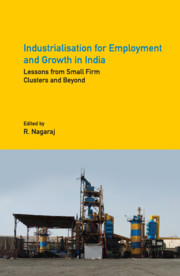Book contents
- Frontmatter
- Contents
- List of Tables
- List of Figures and Maps
- Preface and Acknowledgements
- 1 Introduction
- 2 Garment Cluster in Kolkata: The Untold Story of Expansion Relying on Low-end Domestic Demand
- 3 Constraints to Upgrading and Employment Expansion in the Tiruppur Knitwear Cluster
- 4 Determinants of Employment in the Indian Automobile Industry
- 5 Upgrading Technology and Space as Collective Strategy: Creation of Jobs and Market Potential in Gujarat’s Ceramic Clusters
- 6 Sports Equipment Manufacturing in India: A Firm-level Inquiry into Growth and Employment Dynamism
- 7 Aligarh Lock Cluster: Unravelling the Major Impediments
- 8 Continued Misery or a Change in Fortune? The Case of the Howrah Foundry Industry
- 9 Redevelop and Perish, or Survive and Grow? The Case for Supporting Informal Leather Enterprises in Dharavi, Mumbai
- 10 Growth Performance, Competitiveness and Employment in MSMEs: A Case Study of the Rajkot Engineering Cluster
- 11 Manufacturing and Automation
- About the Contributors
- Index
2 - Garment Cluster in Kolkata: The Untold Story of Expansion Relying on Low-end Domestic Demand
Published online by Cambridge University Press: 31 July 2021
- Frontmatter
- Contents
- List of Tables
- List of Figures and Maps
- Preface and Acknowledgements
- 1 Introduction
- 2 Garment Cluster in Kolkata: The Untold Story of Expansion Relying on Low-end Domestic Demand
- 3 Constraints to Upgrading and Employment Expansion in the Tiruppur Knitwear Cluster
- 4 Determinants of Employment in the Indian Automobile Industry
- 5 Upgrading Technology and Space as Collective Strategy: Creation of Jobs and Market Potential in Gujarat’s Ceramic Clusters
- 6 Sports Equipment Manufacturing in India: A Firm-level Inquiry into Growth and Employment Dynamism
- 7 Aligarh Lock Cluster: Unravelling the Major Impediments
- 8 Continued Misery or a Change in Fortune? The Case of the Howrah Foundry Industry
- 9 Redevelop and Perish, or Survive and Grow? The Case for Supporting Informal Leather Enterprises in Dharavi, Mumbai
- 10 Growth Performance, Competitiveness and Employment in MSMEs: A Case Study of the Rajkot Engineering Cluster
- 11 Manufacturing and Automation
- About the Contributors
- Index
Summary
A persistent delinking of growth and employment during the high-growth phase of the Indian economy followed by sluggish growth and eventually episodes of absolute decline in employment in the aftermath of the 2008 global financial crisis is the pretext for a quest towards a growth trajectory that facilitates gainful employment. The macro indicators of growth slowdown, decline in the growth of corporate capital formation, persistently low capacity utilisation at 70 per cent and simultaneously declining absorption capacity of agriculture resulting in a shift of employment from agriculture to the non-farm sector to the tune of 20 percentage points in the past three decades raise serious doubts about the possibility of mending the widening gap between the growth of output and employment. The relative stagnation of manufacturing in terms of share in gross domestic product (GDP) for the past few decades have been the cause of concern for policymakers. Given the assumed advantages of manufacturing in terms of relatively faster growth in productivity, higher backward and forward linkages and spillover effects as well as the potential to create gainful employment, this sector had attracted policy attention by successive governments (Kaldor 1966, 1967). However, the production structure within manufacturing is undergoing major changes with rising capital intensity and declining employment elasticities. Additionally, in a liberalised regime, the dichotomy between the domestic and the global market is largely attenuated. Erstwhile local monopolies face a competitive market as price takers, and hence are increasingly inclined to introduce technologies borrowed from the global shelf which are expectedly labour displacing in nature. In such a milieu, the dominant mode of industrialisation, namely export-oriented growth strategies with hardly any choice of technologies left and reliance on inserting domestic production structures into global networks as the shortcut towards industrialisation, is unlikely to proffer necessary solutions.
The problem, however, cannot be resolved by a straightforward solution of promoting labour-intensive industries. It is not only about employing labour but employing them gainfully. Interestingly, industries that are relatively more labour intensive show a low share in manufacturing value-added in India, and also the share of labour in value-added in these industries is much lower compared to other industries (Roy 2016).
- Type
- Chapter
- Information
- Industrialisation for Employment and Growth in IndiaLessons from Small Firm Clusters and Beyond, pp. 24 - 48Publisher: Cambridge University PressPrint publication year: 2021



